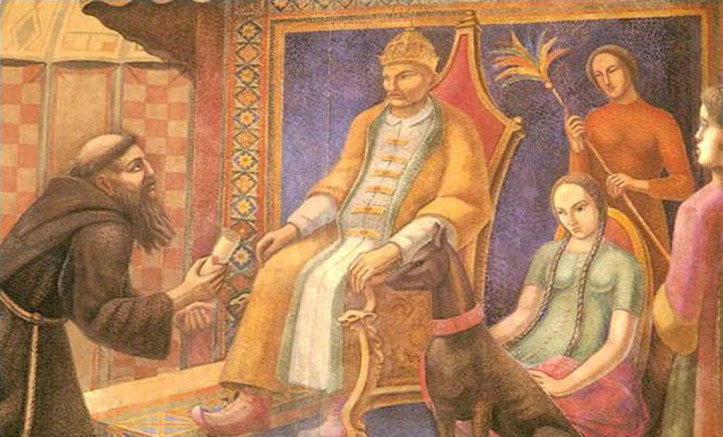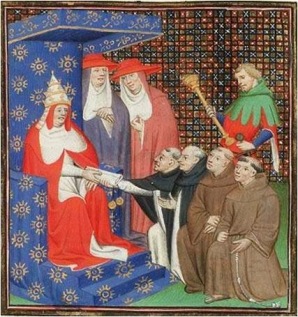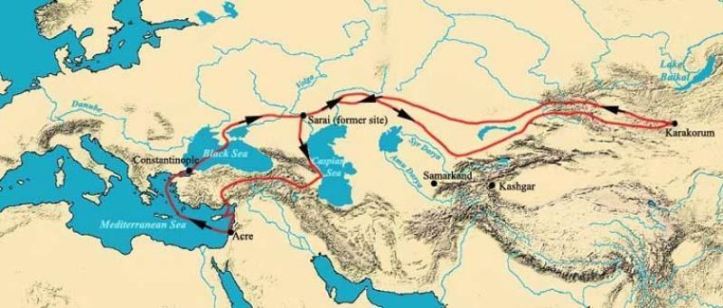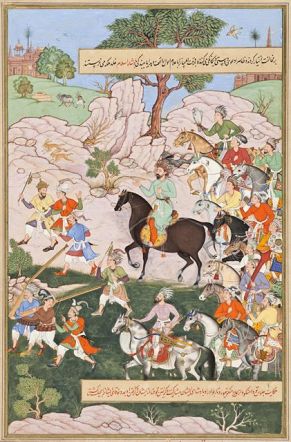
It may come as some surprise that a Mongol khan’s encampment was a pretty international place to be. When the Flemish Franciscan, William of Rubruck, arrived at Mongke Khan’s court in 1253, he found Hungarians, Alans, Russians, Georgians, and Armenians; there were Greek knights, Chinese clergy, an Indian envoy, a Parisian silversmith, Korean and Nicaean ambassadors, the son of an Englishman named Basil, a Christian from Damascus who represented the Ayyubid Sultan, and a woman from Metz who’d been captured in Hungary and since married a Russian builder.
Many, like this last couple, had of course not come there by choice but had been violently wrenched away from their lives. Others, though, had gone there for different reasons. For the right kind of person, the Mongols’ Asian steppe offered an opportunity for self-reinvention, though the consequences of a misstep could be severe (quite literally, if you set foot on the threshold of the khan’s tent, you were killed). Despite these risks, William’s report of his travels gives us two characters–con men, really–who lied about their identities before the great khan himself.

After the Mongol armies vacated Central Europe in 1242, they sparked a series of fascinating travel stories as men made the long trip east to the khan’s court–enslaved, summoned, or sent. In the latter category were a succession of Franciscans and Dominicans on missions that fell somewhere along the spectrum between religion and diplomacy. For example, Friar Giovanni da Pian del Carpine started his journey in 1245 (at over 60 years old) to assess the Mongols’ intentions for Pope Innocent IV and to admonish them for their violence against Christians, and he actually made it all the way to witness the raising of a new great khan, Guyuk, grandson of Genghis, and receive a threatening letter to bring home. Other friars would go too, though not so far: Lawrence of Portugal, Ascelin of Lombardy, and André de Longjumeau. And then there was William of Rubruck.
Friar William wasn’t sent by the pope. Actually, he repeatedly claimed not to have been sent by anyone at all, and there is good reason to believe him; however, his trip was tied to a powerful man, the one he addresses in his written report as (in translation) “Louis, by the grace of God illustrious King of the French.”
King Louis IX was on crusade in the Holy Land, and the Mongols certainly knew about him. They’d been in touch, sending envoys even as he stopped at Cyprus at the outset of his campaign, and there had been men sent the other way too–friars, of course. Whenever Mongols encountered William, that’s exactly what they would have assumed he was, an official envoy of Louis. When one group demanded some gifts from him, as they often did, he refused, and they called him an impostor, a false envoy. It was a pretty serious charge, for the Mongols apparently killed such people whenever they could find them. Who were these con men then, and what did they want?

William never met the first man. He just heard of his story, the story of a cleric from Acre named Theodolus who showed up one day calling himself Raimond. “Raimond” had apparently traveled with King Louis’ 1249 envoy to the Mongols (André de Longjumeau), but we have no other record of his having done so. Maybe he’d simply joined Friar André along the way somewhere. Wherever he joined the friar, he didn’t make the whole trip with him, but remained in Persia, acquiring some musical instruments (sadly unspecified) and going on after André had returned, to the camp of Mongke Khan (Guyuk had enjoyed a fairly short reign). There, he sang a pretty extravagant song of letters from heaven and French submission.
Our other character is Sergius the Armenian monk, who William met in Mongke’s camp. In fact, the Armenian really came to dominate his time there. Sergius’ story is that of a hermit living in the area of Jerusalem who had suddenly begun to experience violent visions of God. With the first two visions, Sergius had been directed to go to the emperor of the Mongols but had not done so. At the third, God had clearly lost patience and cast him down upon the ground, threatening him with death if he continued to ignore his God’s commands. So, naturally, Sergius had gone to the khan, and like Raimond, he’d made extravagant promises that if Mongke would just become Christian, “the whole world would enter into subjection to him, and that the Franks and the Great Pope would obey him.” Sergius the monk was very keen for William to pledge the same. However, he wasn’t really a monk. He told William he had been ordained, but William would later find otherwise. Sergius was an illiterate cloth weaver making a new life for himself among the Mongols.

Raimond’s promise was not so different from the one Sergius made, but his story was. He initially claimed that he had served a mysterious “certain holy bishop,” and that this bishop had received “a missive written on letters of gold,” sent from heaven itself. Raimond was bringing that very letter from heaven to Mongke because the khan “was destined to become master of the whole world.” That all sounded pretty great to Mongke, but where was the letter? “If you had brought the letter that came from Heaven and a letter from your master, you would have been welcome,” he said.
Very welcome, one assumes. But of course, Raimond didn’t have it, and he went with an old excuse: he had been carrying the letters, but, most unfortunately, they had been lost “on the back of an unruly pack horse which had bolted off through forests and over hills,” never to be seen again, obviously. William helpfully noted that these things did happen and travelers did need to be careful to keep a hold of their horse when they weren’t on it.
Thus far, the two men had fairly similar narrative arcs, but their stories were about to diverge. While Sergius carved out a space for himself in the Khan’s encampment, Raimond kept digging himself deeper, sure that some reward was just a few shovelfuls down. Mongke asked him whose kingdom he lived in and who this mysterious bishop was, and Raimond revealed that his master was the Papal Legate on the seventh crusade, Odo of Chateauroux, and that his kingdom was that of the French. And then he said that only some inconvenient Muslims were preventing the French king from sending envoys and seeking peace and friendship. Would Raimond then be willing to guide an embassy to Louis and Odo? Why yes, yes he would.
Sergius seems to have avoided such a direct request, which is bizarre. He’d made similar promises and proposals on a few occasions, yet he had remained in Mongke’s camp. What was he doing there? He wasn’t making friends. In fact, he was getting into all kinds of trouble.

During William’s months with Mongke’s traveling camp and in Karakorum, the Mongol capital, he spent quite a bit of time with Sergius, and serious issues with the Armenian began to trouble him. There was his reliance on the divination services of what might have been a Muslim geomancer. There was his claiming to take only one meal a week, “dough cooked with vinegar for him to drink,” when really he snacked regularly on “almonds, grapes, dried plums and … other fruits,” which he kept beneath the altar. And then there was his tendency to make reckless promises. That had come up when they first met, when Sergius urged William to follow his lead on Frankish submission, but that wasn’t the last of it. When the khan’s wife was deathly ill and Mongke was looking for help, Sergius stepped forward and promised to cure her, even saying that the khan could cut off his head if he failed. With William’s aid, he applied prayer vigils, holy water, and a peculiar rhubarb drink, and, fortunately for Sergius, the patient recovered and he got to keep his head.
And what did he do with his head? He took part in the religious life of the khan’s camp, attending to Mongke’s needs, making the rounds of the royal family, and receiving generous portions of drink along the way. He also behaved with remarkable belligerence towards the other participants in that life. In William’s writing, he’s seen hurling unprovoked insults at Muslims, being goaded into striking at people with a whip, and even claiming responsibility for the death of a senior Nestorian (a Christian of the Church of the East).
That last incident might be most revealing of Sergius’ character and intentions. The story was that this Nestorian had fallen sick, spitting blood sick, and his friends brought in someone William describes as a “Saracen soothsayer,” an interesting choice in itself. This “soothsayer” told them that “A lean man … who neither eats nor drinks nor sleeps in a bed is angry with him,” and everyone somehow immediately identified this as Sergius. They all knew that this sinister “lean man” was the monk, and Sergius didn’t even bother to deny it, quite the opposite. When the man eventually died, after Sergius had been to visit him and trampled on his bed, Sergius told William not to worry: “it was I who killed him with my prayers. He alone was educated and was opposed to us; the rest are ignorant. In future, all of them, and Mongke Khan too, will be at our feet.”

Sergius was not merely a difficult man prone to vanity, aggression, and rash promises. It’s possible that he was actively trying to position himself as the premier religious leader attached to the khan’s traveling court, and this wasn’t so far beyond his reach as you might think. During William’s stay, Mongke demonstrated an openness to different religious positions, just so long as they demonstrated their usefulness and application in this world. Sergius, for all his recklessness, aimed at staying by the khan’s side and achieving power by remaining spiritually useful.
Raimond, on the other hand, brought too many targets into his particular con. Mongke Khan took him up on his offer and sent an ambassador with him bearing an enormous bow that could scarcely be pulled back by two men working together. The bow was intended as a message for Louis. If what Raimond said was true (Mongke wasn’t quite sold on the whole thing), then the bow was to be given to the French king as a gesture of friendship; if not, the ambassador was to tell Louis that “with bows like this we shoot far and hit hard,” a delightfully intimidating gesture, given the bow’s unusual proportions.
Neither the ambassador nor Raimond reached their destination. They got as far as the Emperor of Nicaea, but the emperor was not taken in by Raimond’s story. When he couldn’t produce letters proving his ambassadorship, the emperor’s people took everything Raimond had and threw him in prison while the Mongol ambassador became sick and died. William heard what had become of them from the ambassador’s attendants. “I met them at [Erzurum],” he writes, “on the borders of Turkia, and they told me what had befallen Theodolus [otherwise known as Raimon]. Hoaxers like this scurry about all over the world, and when the [Mongols] succeed in catching them, they put them to death.”
They didn’t catch Sergius, though. When William left him, he was still where the Franciscan had found him, an illiterate cloth weaver successfully playing the holy man, and sometimes the physician, at the court of perhaps the most powerful man in the world.
Devon Field
Sources:
Friar William of Rubruck. The Mission of Friar William of Rubruck, translated by Peter Jackson. The Hakluyt Society, 1990.
Giovanni da Pian del Carpine. The Story of the Mongols: Whom we Call the Tartars, translated by Erik Hildinger. Branden Books, 1996.
 Devon Field is a history podcaster with a Humanities M.A., exploring travel narratives and their place in larger events. Particularly, he’s interested in the Late Medieval and Early Modern periods and their travellers, figures that passed between cultural worlds and revealed sometimes surprising connections. You can hear more about William of Rubruck and others like (and unlike) him on the Human Circus podcast.
Devon Field is a history podcaster with a Humanities M.A., exploring travel narratives and their place in larger events. Particularly, he’s interested in the Late Medieval and Early Modern periods and their travellers, figures that passed between cultural worlds and revealed sometimes surprising connections. You can hear more about William of Rubruck and others like (and unlike) him on the Human Circus podcast.

[…] Hey everyone. Hope you are well. I’ll have a new podcast episode along this week, so watch out for that. In the meantime, I wrote something about liars and con men at Mongke’s court. You can read it here. […]
LikeLike
Enjoyed both above essays. Well researched and smartly composed. Interesting book on drugs in ancient Greece and Rome, which I’d like to recommend but can’t recall title right now! Will get back to you. Was directed to this site by Roseanna Leo.
LikeLike
Thank you so much for stopping by! I’m so pleased to hear you’re enjoying the site. Rosanna Leo is one of our very favorite people!
LikeLike